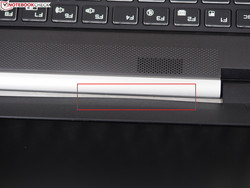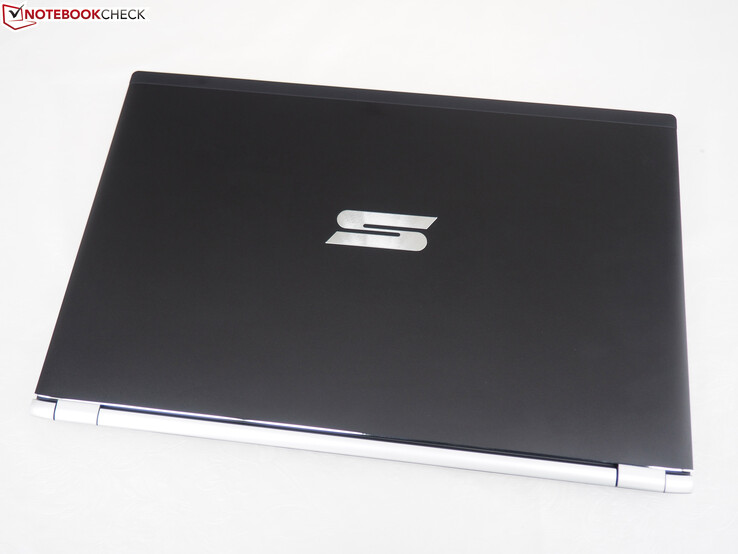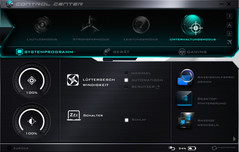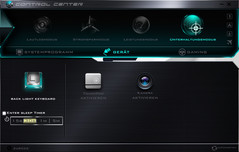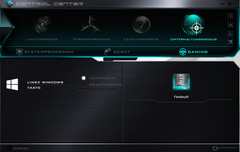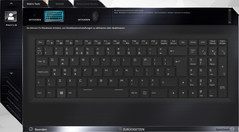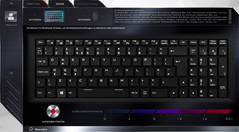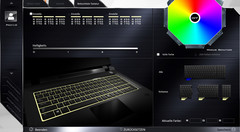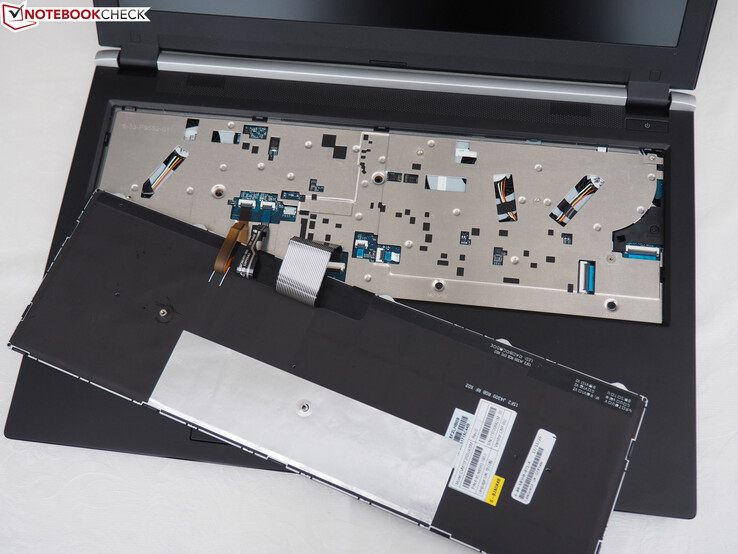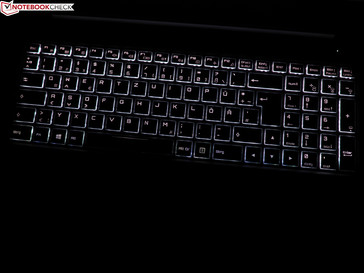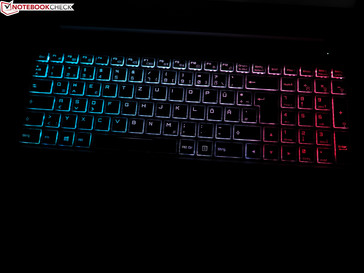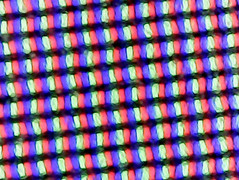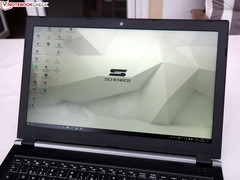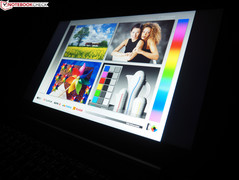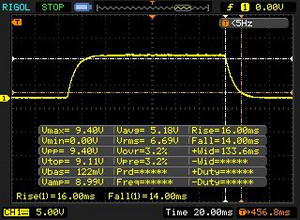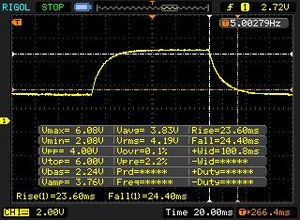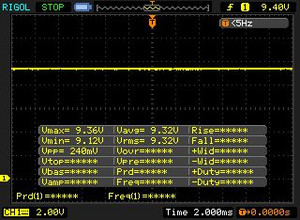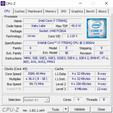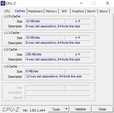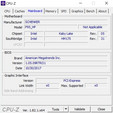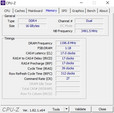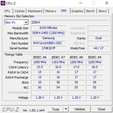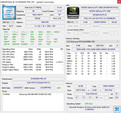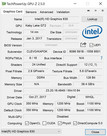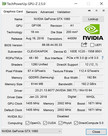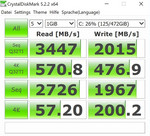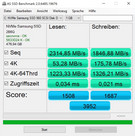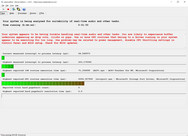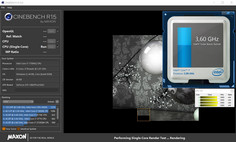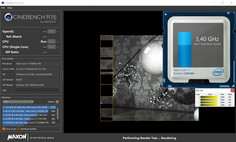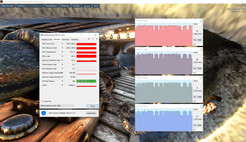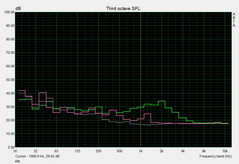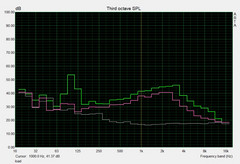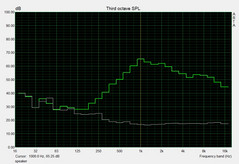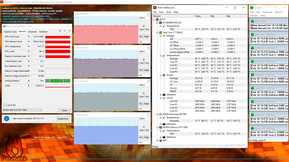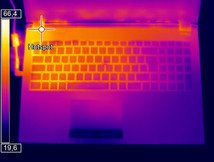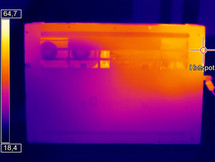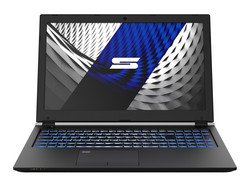Schenker Technologies Key 15 (Clevo P955HP6) Laptop Review

Even though with the GeForce GTX 1060 or GTX 1070 Max-Q, the Key 15 is equipped with a high-end graphics card, Schenker Technologies does not consider its 15-inch product primarily a gaming notebook, but an all-rounder laptop instead. In this price range, the competition is quite large, as our Top 10 Multimedia Laptops list shows. There is a variety of interesting 15-inchers, such as the Dell XPS 15 9560 with a GeForce GTX 1050 or the Asus Zenbook Pro UX550VE with a GeForce GTX 1050 Ti whose design is similarly slim.
However, we should mention the Acer Aspire VN7-593G and Gigabyte Aero 15 GTX-1060 models as its strongest competitors. While the latter impressed us with a great overall performance in the test, since it is unavailable at times (keyword Aero 15X), many users are desperately looking for a comparable notebook. During the course of this article, we are evaluating whether the Key 15 is a real alternative.
One of the greatest highlights already shows during the ordering process. As you are familiar with from Schenker Technologies, the system can be configured extensively in the in-house configurator. While you can get a Full HD and a UHD panel as the display, there are dozens of possible combinations of SSDs and HDDs. In addition, the Key 15 has two DDR4-RAM slots, which can house up to 32 GB of working memory. The customer can also choose the wireless module, the operating system, and the keyboard language. In all cases, a Core i7-7700HQ from Intel's Kaby Lake generation serves as the processor.
Anyone who is content with the basic configuration (FHD display, GTX 1060, 8 GB RAM, 500 GB HDD, no OS) can purchase the Key 15 for 1499 Euros (~$1874). Our test unit, which is equipped with a 4K panel, 2x 8 GB of RAM, a 512 GB SSD, and Windows 10 Home 64 Bit costs about 2200 Euros (~$2750), which if you take away the sharper display panel, is a similar price-performance ratio as the Gigabyte Aero 15 (currently starting from 1900 Euros, ~$2375).
Case
For the case, Schenker Technologies uses a Barebone from Clevo. In contrast to the other cases of the Taiwanese hardware expert, the used P955HP6 Barebone is not a simple plastic brick, but is compelling with its stylish design and materials that appear high-quality, similar to the Gigabyte Aero 15. With the exception of a slightly wobbly lid, the stability is also convincing. Even using stronger force, the base unit hardly shows any give.
In terms of the workmanship, unfortunately our test unit had a larger blemish. As you can see in the picture on the right, the display frame was visibly bulging in one place, despite some manual attempts by the author to latch it in place. Such construction faults should not occur in such an expensive device and caused our impression of the quality to fall behind that of the Gigabyte Aero 15, which showed clean workmanship in our test. However in terms of their surfaces, both devices were affected in quickly becoming dirty and being blemished by fingerprints, due to their dark metal finish.
As for the hinges, which could have been slightly tighter for our tastes, while it is very nice that the notebook can be opened easily with one hand, the lid tends to wobble more when it is jarred, than in other notebooks.
The low weight earns it some positive points. About 2.2 kg (~4.85 lb) are very little for a gaming-capable 15-inch case and warrant easy transport. At 2.5 kg (~5.5 lb), the Acer V15 Nitro BE weighs more than 10% more. The case also earns some respect for its slim build. At 18.6 mm (~0.73 in, according to the handbook), it is even slightly slimmer than the Asus Zenbook Pro UX550VE and the Gigabyte Aero 15. However, due to their slim bezel, those appear more delicate and modern. The same goes for the Dell XPS 15 with its Infinity-Edge design. However, anyone who does not mind the wide bezel will get one of the finest all-rounder notebooks on the market.
Features
Connections
The connection equipment definitely does not need to hide behind the competition. While the Key 15 has a RJ45 port, a 6-in-1 card reader, two audio ports (line-in, line-out), and one USB-3.0 port on the right side, there are two more USB-3.0 ports of Type A and two USB Type-C ports on the left side, which support 3.1-Gen2 speed, but unfortunately not Thunderbolt 3, in contrast to the Aero 15.
The package is completed by three digital display ports. External (4K) displays can either be connected via the HDMI-2.0 port or the two Mini-DisplayPorts at 60 Hz or more. Of course there is also an opening for a Kensington Lock. Note that in order to use the integrated SIM-card slot, you have to select the corresponding UMTS/LTE module during the configuration.
We would call the positioning of the connections less than perfect. Since there are many connections in the front half of the notebook, depending on the peripheral, there can be collisions when using a mouse, and the movement space can become limited in general (this affects left-handed people in particular).
SD Card Reader
The card reader, which handles the SD, SDHC, SDXC, Mini SD, MMC, and RSMMC formats, offers a first-class performance. Only the Dell XPS 15 9560 can beat 210 MB/s during sequential reads of our reference card. When sending photos, the Key 15 achieves first place with its 178 MB/s. The Asus Zenbook Pro UX550VE and the Gigabyte Aero 15 remain below the 100-MB mark. The Acer V15 Nitro, whose card reader creeps along at USB-2.0 level speed, comes in last.
| SD Card Reader | |
| average JPG Copy Test (av. of 3 runs) | |
| Schenker Key 15 (Toshiba Exceria Pro SDXC 64 GB UHS-II) | |
| Dell XPS 15 9560 (i7-7700HQ, UHD) (Toshiba Exceria Pro SDXC 64 GB UHS-II) | |
| Average of class Multimedia (21.1 - 198, n=41, last 2 years) | |
| Gigabyte Aero 15 (Toshiba Exceria Pro SDXC 64 GB UHS-II) | |
| Asus Zenbook Pro UX550VE-DB71T (Toshiba Exceria Pro SDXC 64 GB UHS-II) | |
| Acer Aspire VN7-593G-73HP V15 Nitro BE | |
| maximum AS SSD Seq Read Test (1GB) | |
| Dell XPS 15 9560 (i7-7700HQ, UHD) (Toshiba Exceria Pro SDXC 64 GB UHS-II) | |
| Schenker Key 15 (Toshiba Exceria Pro SDXC 64 GB UHS-II) | |
| Average of class Multimedia (27.4 - 262, n=41, last 2 years) | |
| Asus Zenbook Pro UX550VE-DB71T (Toshiba Exceria Pro SDXC 64 GB UHS-II) | |
| Gigabyte Aero 15 (Toshiba Exceria Pro SDXC 64 GB UHS-II) | |
| Acer Aspire VN7-593G-73HP V15 Nitro BE | |
Communication
While a Realtek controller is responsible for the communication via RJ45-Gigabit LAN, the wireless connection is handled by a module from Intel or Rivet Networks. With the Wireless-AC 8265, our test unit has received a very popular notebook adapter, which achieves a good to very good performance. Our WiFi test, which is performed at a distance of one meter from the router, attested the Key 15 with 507 MB/s on average during sending and 677 MB/s while receiving. With this, the 15-incher remains inconspicuous among the rest of the competition.
Software
While other manufacturers like to drown their notebooks in superfluous software, Schenker Technologies limits itself to the bare necessities. In addition to several driver programs, you only see two extra tools on the right side of the task bar. One is the Control Center, which shines with four performance modes and various detail adjustments including fan control, and the other is Flexikey, which allows you to create macros and modify the keyboard illumination.
Accessories
The manufacturer also earns some praise for the accessories which are quite abundant. At this point, a handbook, a driver DVD, and a recovery DVD cannot be taken for granted anymore. Since the Key 15 has to make do without an optical drive, Schenker also adds a USB stick as a small goody into the box. In the GTX-1060 model, a 150-Watt power supply, which weighs 0.49 kg (~1 lb) and measures about 16 x 7.5 x 2.5 cm (~6.3 x 3 x 1 in), is responsible for supplying the power.
Maintenance
The maintenance of the P955HP6 Barebone is more complex than necessary in our opinion. In order to remove the bottom plate, unfortunately it is not enough to remove the 11 screws on the bottom. In addition, you also have to remove the keyboard, which hides 5 additional screws that hold the base unit (see picture). You only get access to the hardware after completing this step.
The inner workings remind strongly of the P950HP6 Barebone brother, which we tested in form of the Guru Fire KS. The cooling system consists of two fans for the GPU and one fan for the CPU. Furthermore, there are two RAM slots, one M.2 slot with NVMe/PCIe support, and one 2.5-inch slot which can only fit HDDs with a maximum thickness of 7 mm (~0.28 in)! As customary nowadays, the battery is screwed into the case.
Warranty
The warranty lasts 24 or 36 months (pick-up-&-return service including one check-up). If you like, you can also extend the quick-repair from half the duration of the warranty to cover the whole duration.
Please see our Guarantees, Return Policies and Warranties FAQ for country-specific information.
Input Devices
Keyboard
The input devices should satisfy most of the demands. As the keyboard, a chiclet model with a dedicated number block is used. At 15 x 15 mm (~0.59 x 0.59 in), the letter and number keys are sufficiently large (distance between keys: about 3 mm, ~0.12 in). Whether you like the comfortably large arrow keys, which are set between the main and the number block, depends on your personal preferences. Otherwise the layout conforms to a large extent to the German standard, so there are no experiences like in the MSI (single row Enter key, etc.).
Apropos MSI: while the multiple step RGB illumination, which can be separated into up to three zones, scores with a good brightness and an even illumination that facilitates evening gaming sessions, the color accuracy could be better at the bottom edge. With the white illumination, which is activated by default, some areas turn into the blue range. We often notice similar phenomena with MSI notebooks.
The typing experience itself offers hardly any reason for complaint. Even if the key strokes could be more exact and especially less noisy (the stroke is slightly undefined in our opinion), the keyboard offers a quite good typing experience.
Touchpad
In terms of the mouse alternative, the Clevo Barebone developer decided against the current trend and built in a classical touchpad with dedicated keys. While they clattered a bit, they worked reliably. The word "reliable" is also suitable for the multi-touch support. Zooming and scrolling via two-finger gestures worked flawlessly.
The manufacturer could make some improvements in the touchpad surface. Due to the finish which appears slightly roughened, the sliding characteristics are not quite as good as in other notebooks. On the other hand, the touchpad offers a fingerprint scanner in its left top corner. The size of the touchpad is 10.8 x 6.2 cm (~4.25 x 2.44 in), which is a decent value.
Display
Whether it is the Full HD or the UHD version, the display of the Key 15 is based on the IPS technology which, although having stable viewing angles, does not react as fast as the TN models. The 30 ms black-to-white and 48 ms grey-to-grey that are achieved by our tested 4K model are very poor on paper, even though subjectively, we did not notice any streaks.
| |||||||||||||||||||||||||
Brightness Distribution: 84 %
Center on Battery: 285 cd/m²
Contrast: 1018:1 (Black: 0.28 cd/m²)
ΔE ColorChecker Calman: 4.09 | ∀{0.5-29.43 Ø4.77}
ΔE Greyscale Calman: 4.39 | ∀{0.09-98 Ø5}
92% sRGB (Argyll 1.6.3 3D)
60% AdobeRGB 1998 (Argyll 1.6.3 3D)
67.6% AdobeRGB 1998 (Argyll 3D)
92.4% sRGB (Argyll 3D)
66.7% Display P3 (Argyll 3D)
Gamma: 2.32
CCT: 6706 K
| Schenker Key 15 AUO22EB, IPS, 3840x2160 | Gigabyte Aero 15 N156HCA-EA1 (CMN15D7), IPS, 1920x1080 | Acer Aspire VN7-593G-73HP V15 Nitro BE LG Display LP156WF6-SPP1, AH-IPS, Normally Black, Transmissive, 1920x1080 | Asus Zenbook Pro UX550VE-DB71T N156HCE-EN1 (CMN15E8), IPS, 1920x1080 | Dell XPS 15 9560 (i7-7700HQ, UHD) IGZO IPS, 3840x2160 | |
|---|---|---|---|---|---|
| Display | -1% | -6% | -3% | 30% | |
| Display P3 Coverage (%) | 66.7 | 65.2 -2% | 65.8 -1% | 64.3 -4% | 89.7 34% |
| sRGB Coverage (%) | 92.4 | 92.5 0% | 85.1 -8% | 90.4 -2% | 100 8% |
| AdobeRGB 1998 Coverage (%) | 67.6 | 66.5 -2% | 62.2 -8% | 65.3 -3% | 100 48% |
| Response Times | 2% | 1% | 1% | -25% | |
| Response Time Grey 50% / Grey 80% * (ms) | 48 ? | 42.8 ? 11% | 41 ? 15% | 43.2 ? 10% | 57.2 ? -19% |
| Response Time Black / White * (ms) | 30 ? | 32 ? -7% | 34 ? -13% | 32.8 ? -9% | 39.2 ? -31% |
| PWM Frequency (Hz) | 26000 ? | 25510 ? | 962 | ||
| Screen | -9% | -5% | -19% | 2% | |
| Brightness middle (cd/m²) | 285 | 320 12% | 322 13% | 288.2 1% | 370.1 30% |
| Brightness (cd/m²) | 293 | 316 8% | 297 1% | 266 -9% | 356 22% |
| Brightness Distribution (%) | 84 | 90 7% | 86 2% | 75 -11% | 87 4% |
| Black Level * (cd/m²) | 0.28 | 0.36 -29% | 0.31 -11% | 0.3 -7% | 0.37 -32% |
| Contrast (:1) | 1018 | 889 -13% | 1039 2% | 961 -6% | 1000 -2% |
| Colorchecker dE 2000 * | 4.09 | 4.62 -13% | 4.73 -16% | 5.5 -34% | 5.3 -30% |
| Colorchecker dE 2000 max. * | 7.94 | 9.75 -23% | 12.37 -56% | 11.3 -42% | 9.9 -25% |
| Greyscale dE 2000 * | 4.39 | 6 -37% | 2.99 32% | 7.9 -80% | 4.6 -5% |
| Gamma | 2.32 95% | 2.46 89% | 2.32 95% | 2.09 105% | 2.31 95% |
| CCT | 6706 97% | 6761 96% | 6905 94% | 6559 99% | 6284 103% |
| Color Space (Percent of AdobeRGB 1998) (%) | 60 | 60 0% | 56 -7% | 58.5 -2% | 88.3 47% |
| Color Space (Percent of sRGB) (%) | 92 | 92 0% | 85 -8% | 90 -2% | 100 9% |
| Total Average (Program / Settings) | -3% /
-6% | -3% /
-4% | -7% /
-13% | 2% /
4% |
* ... smaller is better
More annoying to us seemed the slight to medium-strong light halos on the edge, which are often seen in the notebook segment but only become conspicuous in specific conditions (very even or dark image).
In the remaining categories, the UHD monitor strikes a great figure. An average brightness of 293 cd/m² as well as a contrast of around 1000:1 (black value: 0.28 cd/m²) should be sufficient for most buyers.
While the color accuracy is not unusual either, we recommend calibration to professional users. We were able to lower the existing deviations to a Delta-E value of 1 (Grayscales) and 3 (ColorChecker) using our equipment (the ICC file is linked above).
The 4K panel is able to cover a good 92% of the sRGB color space and still 60% of AdobeRGB. While this is clearly less than in the UHD model of the XMG Pro 17 (87% AdobeRGB), everyday life applications such as videos or games are displayed adequately.
We should rather talk about the resolution. Due to the high computing requirements, 3840x2160 pixels are the limits for a GeForce GTX 1060 or GTX 1070 Max-Q, as we will also see later in the gaming benchmarks. It is therefore too bad that there is currently no WQHD option in the configurator, since 2560x1440 pixels would be the perfect solution in between.
Display Response Times
| ↔ Response Time Black to White | ||
|---|---|---|
| 30 ms ... rise ↗ and fall ↘ combined | ↗ 16 ms rise | |
| ↘ 14 ms fall | ||
| The screen shows slow response rates in our tests and will be unsatisfactory for gamers. In comparison, all tested devices range from 0.1 (minimum) to 240 (maximum) ms. » 79 % of all devices are better. This means that the measured response time is worse than the average of all tested devices (20.2 ms). | ||
| ↔ Response Time 50% Grey to 80% Grey | ||
| 48 ms ... rise ↗ and fall ↘ combined | ↗ 23.6 ms rise | |
| ↘ 24.4 ms fall | ||
| The screen shows slow response rates in our tests and will be unsatisfactory for gamers. In comparison, all tested devices range from 0.165 (minimum) to 636 (maximum) ms. » 82 % of all devices are better. This means that the measured response time is worse than the average of all tested devices (31.6 ms). | ||
Screen Flickering / PWM (Pulse-Width Modulation)
| Screen flickering / PWM not detected | |||
In comparison: 53 % of all tested devices do not use PWM to dim the display. If PWM was detected, an average of 8084 (minimum: 5 - maximum: 343500) Hz was measured. | |||
Performance
Regardless of the selected graphics card, we would count the Key 15 into the high-end range. Thus you could not only call it a multimedia, but also a gaming notebook, despite the lacking G-Sync support. Thanks to the Kaby Lake CPU and the Pascal GPU, it offers an appealing performance in both usage areas. Correspondingly, you should configure the Key 15 with at least 16 GB of RAM and a Solid State Drive for the operating system.
Processor
Even if the Key 15 would already run well and be an attractive all around package with an energy efficient CPU (such as the Core i7-8550U), the manufacturer wanted to make sure and equipped the 15-incher with a "full" notebook chip with 45 instead of 15 watts TDP. The Core i7-7700HQ is one of the most successful 14 nm models from Intel, which runs at up to 3.8 GHz under load.
We tested with Cinebench R15, whether the automatic Turbo can really take effect fully. While the first result was still at the expected level, the performance drops slightly starting with the second run. Instead of 3.4 GHz, which is what Intel specifies for the full load of all the cores, the Key 15 then only reaches 3.2 GHz. At an average of 3.6 GHz in the single-core load, the Kaby Lake CPU does not quite achieve its Turbo maximum either.
However, since we only speak about a 200 MHz difference to other 7700HQ notebooks, the difference is only minimally - if at all - noticeable in practice. In the benchmarks the Key 15 ran through without any prior load, the speed was similar to that of the competitors.
System Performance
When using an SSD, the system performance is up to the current standards. Windows boots up very fast, and programs most often react extremely fast (except for certain latency problems, which the XMG Pro 17 also had). Despite having a stronger GPU, our tested configuration comes in just behind the Asus Zenbook Pro UX550VE in PCMark 10. However, we should take the PCMark scores with some grain of salt, since they are not always comprehensible in our experience (especially in PCMark 8).
| PCMark 8 Home Score Accelerated v2 | 3499 points | |
| PCMark 8 Work Score Accelerated v2 | 4328 points | |
| PCMark 10 Score | 4493 points | |
Help | ||
Storage Solution
Schenker does not make any compromises in the storage solution. Our test unit is driven by one of the fastest PCIe models that is currently available. The 512 GB version of the Samsung 960 Pro wipes the floor with almost all the competitors. To give an an example, in the AS-SSD benchmark, the LiteON drive of the Dell XPS 15 9560 is almost 30% behind. Even the in-house Samsung PM961 has difficulties in the direct comparison. Of course, anyone who would like to save a little money can also equip the M.2 slot with a more affordable SATA-III SSD, which is sufficient for most purposes. For large amounts of data, an additional HDD for the 2.5-inch slot also makes sense.
| Schenker Key 15 Samsung SSD 960 Pro 512 GB m.2 | Gigabyte Aero 15 Lite-On CX2-8B512-Q11 | Acer Aspire VN7-593G-73HP V15 Nitro BE Seagate Mobile HDD 1TB ST1000LM035 | Asus Zenbook Pro UX550VE-DB71T Samsung PM961 NVMe MZVLW512HMJP | Dell XPS 15 9560 (i7-7700HQ, UHD) Lite-On CX2-8B512-Q11 | Average Samsung SSD 960 Pro 512 GB m.2 | |
|---|---|---|---|---|---|---|
| AS SSD | -12% | -28% | -5% | |||
| Seq Read (MB/s) | 2315 | 2208 -5% | 2026 -12% | 2551 ? 10% | ||
| Seq Write (MB/s) | 1847 | 1475 -20% | 1207 -35% | 1918 ? 4% | ||
| 4K Read (MB/s) | 53.3 | 51 -4% | 41.34 -22% | 45.1 ? -15% | ||
| 4K Write (MB/s) | 175.8 | 112.8 -36% | 112.2 -36% | 136.4 ? -22% | ||
| Score Read (Points) | 1508 | 1541 2% | 1206 -20% | 1460 ? -3% | ||
| Score Write (Points) | 1687 | 1421 -16% | 1022 -39% | 1639 ? -3% | ||
| Score Total (Points) | 3952 | 3721 -6% | 2810 -29% | 3820 ? -3% |
Graphics Card
Besides the display, the graphics card also has a strong influence on the overall experience which should not be underestimated (power consumption, emissions, battery life, etc.). Even though the GeForce GTX 1060 offers less performance, the Key 15 should not only be cooler, but also quieter with the GeForce GTX 1070 Max-Q, since the Max-Q models were trimmed for efficiency. However, the premium of more than 300 Euros (~$375) is hard to swallow, in particular since the GTX 1070 Max-Q is not always a match to its standard version.
Our test unit is "only" equipped with the GTX 1060. This DirectX-12 model from Nvidia's Pascal series has 6 GB of GDDR5-VRAM and is able to dynamically over-clock comparable to the Intel CPUs. The range is between the standard of 1405 MHz up to 1900 MHz. In the test with the Unigine-Heaven-4.0 benchmark, the core ran at about 1600 MHz, which is a typical value for the GTX 1060.
In the GPU benchmarks, the Key 15 showed the weaker multimedia companions how it can be done. For example, the GeForce GTX 1050 Ti of the Asus Zenbook Pro UX550VE is surpassed by more than 50%, and the advantage to the GTX 1050 of the Dell XPS 15 9560 is even almost 90%.
| 3DMark 11 Performance | 12633 points | |
| 3DMark Cloud Gate Standard Score | 25268 points | |
| 3DMark Fire Strike Score | 9744 points | |
| 3DMark Time Spy Score | 3748 points | |
Help | ||
Unfortunately, the Key 15 is confronted with another problem during higher 3D loads. Our Witcher-3 test (60 minutes @ FHD/Ultra) lead to the CPU Turbo being completely deactivated. Even though 2.8 GHz are sufficient for continuing smooth game play, due to the lacking Turbo, the frame rates drop slightly in games that are demanding on the CPU such as "Final Fantasy XV." The situation was even worse in the P950HP6 Barebone brother, whose CPU tended to throttle to 1.6 GHz under load. Clevo should make some improvements here.
Gaming Performance
If you are able to make do with 1920x1080 pixels, the GeForce GTX 1060 most often has enough reserves for high to maximum settings. For example, "Wolfenstein II" and "Fortnite" even still run smoothly in the Extreme or Epic preset. Things only become tighter in extremely demanding games.
| The Witcher 3 | |
| 1920x1080 Ultra Graphics & Postprocessing (HBAO+) | |
| Average of class Multimedia (11 - 121, n=28, last 2 years) | |
| Schenker Key 15 | |
| Average NVIDIA GeForce GTX 1060 Mobile (24 - 42.3, n=60) | |
| Acer Aspire VN7-593G-73HP V15 Nitro BE | |
| Gigabyte Aero 15 | |
| Asus Zenbook Pro UX550VE-DB71T | |
| Dell XPS 15 9560 (i7-7700HQ, UHD) | |
| 1920x1080 High Graphics & Postprocessing (Nvidia HairWorks Off) | |
| Average of class Multimedia (22 - 242, n=27, last 2 years) | |
| Schenker Key 15 | |
| Gigabyte Aero 15 | |
| Acer Aspire VN7-593G-73HP V15 Nitro BE | |
| Average NVIDIA GeForce GTX 1060 Mobile (52.6 - 80.6, n=49) | |
| Dell XPS 15 9560 (i7-7700HQ, UHD) | |
The GTX 1060 is hardly suited for the 4K realm. At 3840x2160 pixels, all the tested games stuttered strongly. Even a reduction to medium details did not always ensure a decent frame rate. Correspondingly, the user often has no choice but to make do with a lower resolution.
Passionate gamers need at least a GTX 1080 (Max-Q) for UHD displays. Since besides the performance, the power consumption and battery life also suffer from the high amount of pixels, gaming fans are better served with the Full HD version of the Key 15.
| low | med. | high | ultra | 4K | |
|---|---|---|---|---|---|
| The Witcher 3 (2015) | 73.9 | 40.2 | 26.1 | ||
| Wolfenstein II: The New Colossus (2017) | 78 | 72.2 | 27.1 | ||
| Fortnite (2018) | 99.6 | 77.5 | 22.7 | ||
| Final Fantasy XV Benchmark (2018) | 37.2 | 16.4 | |||
| Kingdom Come: Deliverance (2018) | 60.3 | 43.9 | 13.9 |
Emissions
Noise Emmissions
To say it gently, the Clevo Barebones often show a curious fan behavior. The P955HP6 is no exception here. Although the tested configuration is either completely silent or very quiet at 31–32 dB in idle mode (with many notebooks having a more pleasant frequency though), smaller tasks such as Windows Updates, the opening of the web browser or playing of videos quickly tempt the CPU fan to rev up by an unnecessary amount. We recently complained about the same thing in the XMG Pro 17. Since the system revs up towards a very loud 40 dB even during the booting process from time to time, the 15-incher is not well-suited for quieter surroundings (libraries, etc.).
While the two GPU fans tend to only become noticeable during load, they then run with a very noticeable and at times even annoyingly loud level of 47 dB (3DMark 06) to 54 dB (stress test). An average of 49 dB during actual gaming sessions are also no piece of pie. So noise sensitive users should grab a headset or rather even look for an alternative. Other GTX-1060 notebooks such as the Gigabyte Aero 15 and the Acer V15 Nitro are considerably quieter in 3D mode. Overall, the fan settings need more than a small improvement. If Clevo does not correct this with a BIOS update, the buyers may have to manually adjust this (Control Center).
Noise level
| Idle |
| 31 / 32 / 39 dB(A) |
| Load |
| 47 / 54 dB(A) |
 | ||
30 dB silent 40 dB(A) audible 50 dB(A) loud |
||
min: | ||
| Schenker Key 15 GeForce GTX 1060 Mobile, i7-7700HQ | Gigabyte Aero 15 GeForce GTX 1060 Mobile, i7-7700HQ | Acer Aspire VN7-593G-73HP V15 Nitro BE GeForce GTX 1060 Mobile, i7-7700HQ | Asus Zenbook Pro UX550VE-DB71T GeForce GTX 1050 Ti Mobile, i7-7700HQ | Dell XPS 15 9560 (i7-7700HQ, UHD) GeForce GTX 1050 Mobile, i7-7700HQ | |
|---|---|---|---|---|---|
| Noise | 5% | 8% | 8% | 6% | |
| off / environment * (dB) | 29 | 31 -7% | 30.4 -5% | 28.3 2% | 28.4 2% |
| Idle Minimum * (dB) | 31 | 32 -3% | 30.9 -0% | 30.4 2% | 29 6% |
| Idle Average * (dB) | 32 | 33 -3% | 30.9 3% | 31 3% | 29 9% |
| Idle Maximum * (dB) | 39 | 34 13% | 31.5 19% | 31.2 20% | 32.2 17% |
| Load Average * (dB) | 47 | 39 17% | 40.7 13% | 43.3 8% | 47.1 -0% |
| Witcher 3 ultra * (dB) | 49 | 43 12% | 45.5 7% | 46.2 6% | 52 -6% |
| Load Maximum * (dB) | 54 | 50 7% | 43.9 19% | 46.2 14% | 47.1 13% |
* ... smaller is better
Temperature
In contrast to the noise development, the case temperatures are not above average. After two hours of idling, we only measured 21 - 24 °C (70 - 75 °F) on the top and bottom of the Key 15. Those values are pleasantly low. In the gaming test with "The Witcher 3," the surfaces did not become too hot either at 25 - 45 °C (75 - 113 °F). They only become hot in the full-load scenarios that lack practical relevance. Here the back third of the case heats up to 55 °C (131 °F) on top and 56 °C (133 °F) on the bottom. The palm rest always remains within a comfortably cool range.
Under the hood, the situation is less rosy. While the GeForce GTX 1060 reaches only 75 °C (176 °F) in the stress test with the Furmark and Prime95 tools (throttling to about 1230 MHz), the CPU scrapes at the temperature limit of 100 °C (212 °F) despite the Turbo being deactivated. It looks as if the cooling system is a bit too weak for the Core i7-7700HQ.
(-) The maximum temperature on the upper side is 55 °C / 131 F, compared to the average of 36.9 °C / 98 F, ranging from 21.1 to 71 °C for the class Multimedia.
(-) The bottom heats up to a maximum of 56 °C / 133 F, compared to the average of 39.2 °C / 103 F
(+) In idle usage, the average temperature for the upper side is 22 °C / 72 F, compared to the device average of 31.3 °C / 88 F.
(±) Playing The Witcher 3, the average temperature for the upper side is 36 °C / 97 F, compared to the device average of 31.3 °C / 88 F.
(+) The palmrests and touchpad are reaching skin temperature as a maximum (35 °C / 95 F) and are therefore not hot.
(-) The average temperature of the palmrest area of similar devices was 28.7 °C / 83.7 F (-6.3 °C / -11.3 F).
| Schenker Key 15 GeForce GTX 1060 Mobile, i7-7700HQ | Gigabyte Aero 15 GeForce GTX 1060 Mobile, i7-7700HQ | Acer Aspire VN7-593G-73HP V15 Nitro BE GeForce GTX 1060 Mobile, i7-7700HQ | Asus Zenbook Pro UX550VE-DB71T GeForce GTX 1050 Ti Mobile, i7-7700HQ | Dell XPS 15 9560 (i7-7700HQ, UHD) GeForce GTX 1050 Mobile, i7-7700HQ | |
|---|---|---|---|---|---|
| Heat | -5% | -10% | 4% | 4% | |
| Maximum Upper Side * (°C) | 55 | 56 -2% | 51.9 6% | 43.2 21% | 48.8 11% |
| Maximum Bottom * (°C) | 56 | 61 -9% | 54.6 2% | 49.8 11% | 42.6 24% |
| Idle Upper Side * (°C) | 23 | 25 -9% | 29.1 -27% | 24.8 -8% | 26 -13% |
| Idle Bottom * (°C) | 24 | 24 -0% | 29.3 -22% | 26 -8% | 25.4 -6% |
* ... smaller is better
Speakers
The speakers did not knock our socks off either. Even with the Sound-Blaster technology turned on, the audio contents sound relatively bland, unbalanced, and tinny. In addition, the maximum volume is low, and there is hardly any bass. Although the Aero 15 has no sub-woofer either, movies, games, and music sounds much better in parts on the device from Gigabyte. If possible, you should therefore listen to the Key 15 with headphones or external speakers. A manual sound tuning might possibly also be worthwhile. The various menus of the audio software are depicted below.
Schenker Key 15 audio analysis
(-) | not very loud speakers (71 dB)
Bass 100 - 315 Hz
(-) | nearly no bass - on average 19.2% lower than median
(±) | linearity of bass is average (7.3% delta to prev. frequency)
Mids 400 - 2000 Hz
(±) | higher mids - on average 7.9% higher than median
(±) | linearity of mids is average (10.8% delta to prev. frequency)
Highs 2 - 16 kHz
(+) | balanced highs - only 2.7% away from median
(+) | highs are linear (6.2% delta to prev. frequency)
Overall 100 - 16.000 Hz
(±) | linearity of overall sound is average (29.9% difference to median)
Compared to same class
» 95% of all tested devices in this class were better, 2% similar, 3% worse
» The best had a delta of 5%, average was 17%, worst was 45%
Compared to all devices tested
» 88% of all tested devices were better, 3% similar, 10% worse
» The best had a delta of 4%, average was 24%, worst was 134%
Gigabyte Aero 15 audio analysis
(±) | speaker loudness is average but good (79 dB)
Bass 100 - 315 Hz
(-) | nearly no bass - on average 23.3% lower than median
(±) | linearity of bass is average (10.7% delta to prev. frequency)
Mids 400 - 2000 Hz
(+) | balanced mids - only 1.8% away from median
(+) | mids are linear (4.1% delta to prev. frequency)
Highs 2 - 16 kHz
(+) | balanced highs - only 2.6% away from median
(+) | highs are linear (5.1% delta to prev. frequency)
Overall 100 - 16.000 Hz
(±) | linearity of overall sound is average (18.3% difference to median)
Compared to same class
» 54% of all tested devices in this class were better, 7% similar, 39% worse
» The best had a delta of 5%, average was 17%, worst was 45%
Compared to all devices tested
» 39% of all tested devices were better, 8% similar, 53% worse
» The best had a delta of 4%, average was 24%, worst was 134%
Frequency comparison (checkboxes selectable!)
Power Management
Power Consumption
Thanks to the Optimus technology, the Key 15 is able to switch between the Nvidia GPU and the graphics chip of the processor at a whim, which minimizes the power needs. 7 - 18 watts during idle mode are very little for a gaming-capable multimedia notebook, although the consumption jumps higher at times without a discernible reason. Nonetheless, the Gigabyte Aero 15 uses more power during idle, even if it only has a Full HD instead of a 4K panel. There is hardly any difference between the two GTX-1060 laptops under load. 82 - 154 watts (111 watts during "The Witcher 3") are okay for the offered frame rates, even though the 150 W power supply reaches its limits here.
| Off / Standby | |
| Idle | |
| Load |
|
Key:
min: | |
| Schenker Key 15 GeForce GTX 1060 Mobile, i7-7700HQ | Gigabyte Aero 15 GeForce GTX 1060 Mobile, i7-7700HQ | Acer Aspire VN7-593G-73HP V15 Nitro BE GeForce GTX 1060 Mobile, i7-7700HQ | Asus Zenbook Pro UX550VE-DB71T GeForce GTX 1050 Ti Mobile, i7-7700HQ | Dell XPS 15 9560 (i7-7700HQ, UHD) GeForce GTX 1050 Mobile, i7-7700HQ | |
|---|---|---|---|---|---|
| Power Consumption | -23% | -2% | 22% | -21% | |
| Idle Minimum * (Watt) | 7 | 12 -71% | 7.2 -3% | 6.3 10% | 11.9 -70% |
| Idle Average * (Watt) | 10 | 15 -50% | 10.5 -5% | 7.9 21% | 17.1 -71% |
| Idle Maximum * (Watt) | 18 | 20 -11% | 16 11% | 8.1 55% | 17.3 4% |
| Load Average * (Watt) | 82 | 82 -0% | 82 -0% | 84.9 -4% | 94.7 -15% |
| Witcher 3 ultra * (Watt) | 111 | 111 -0% | 124 -12% | 96.3 13% | 104.8 6% |
| Load Maximum * (Watt) | 154 | 161 -5% | 155 -1% | 102.4 34% | 122 21% |
* ... smaller is better
Battery Life
Since with its low weight and compact measurements, the Key 15 screams mobility, we had hoped for a good battery life beforehand. Unfortunately, our test configuration with the GTX 1060 and 4K panel can only rarely deliver this. Even though the 15-incher manages up to 8 hours in the Readers test of Battery Eater (minimal brightness), barely 3.5 hours of playing video and 4 hours of surfing the Internet via WLAN in medium brightness are poor in view of the graphics switching. The reason for this poor outcome is quickly found. While the competitors are trying to capture customers with 69 - 97 Wh batteries, Clevo only uses a 55 Wh model in the P955HP6 case, which is too little for the price and the "all-rounder" concept.
Gaming without a power supply also brings only limited joy. On one hand, it is finished after 75 minutes at most in 3D operation (maximum brightness), and on the other hand there are fluctuations in the CPU and GPU clock speed, as in many notebooks. For example, in "The Witcher 3" (1920x1080, Ultra), the frame rate dropped from about 40 FPS to 15–30 FPS.
| Schenker Key 15 GeForce GTX 1060 Mobile, i7-7700HQ, 55 Wh | Gigabyte Aero 15 GeForce GTX 1060 Mobile, i7-7700HQ, 94.24 Wh | Acer Aspire VN7-593G-73HP V15 Nitro BE GeForce GTX 1060 Mobile, i7-7700HQ, 69 Wh | Asus Zenbook Pro UX550VE-DB71T GeForce GTX 1050 Ti Mobile, i7-7700HQ, 73 Wh | Dell XPS 15 9560 (i7-7700HQ, UHD) GeForce GTX 1050 Mobile, i7-7700HQ, 97 Wh | Average of class Multimedia | |
|---|---|---|---|---|---|---|
| Battery runtime | 67% | 47% | 76% | 62% | 186% | |
| Reader / Idle (h) | 8 | 10.6 33% | 8.4 5% | 17.1 114% | 13.9 74% | 23.4 ? 193% |
| H.264 (h) | 3.6 | 7.7 114% | 15.8 ? 339% | |||
| WiFi v1.3 (h) | 4 | 7 75% | 6 50% | 8.9 123% | 7.2 80% | 11.3 ? 183% |
| Load (h) | 1.3 | 1.9 46% | 2.4 85% | 1.2 -8% | 1.7 31% | 1.653 ? 27% |
Verdict
Pros
Cons
Multimedia notebooks are a dime a dozen. However, if it should be a stylish and slim metal case with a decent performance, countless products drop out. The Key 15 by Schenker Technologies, on the other hand, fulfills all the criteria and advances to be a successful all-rounder.
On the positive side, there is mainly the low weight, which makes transport very comfortable. Just from looking at the 15-incher, you would hardly expect the powerful hardware. But the system could also go as a high-end notebook. You can rarely find so much performance in so little space. Most of the buyers should be pleased with the connections, input devices, and display.
However, the Key 15 has a hard time to keep up against the multimedia elite. In particular the Aero 15, which is also available with the GTX 1060 and GTX 1070 Max-Q, runs ahead of the Schenker Notebook on several occasions. Not only is the Gigabyte competitor quieter, but it also scores with a better sound, a more stable CPU speed, and - by leaving out the 2.5-inch slot - with a significantly larger battery. For some users, the Thunderbolt-3 port might also be an argument for the Aero 15.
Schenker Key 15
- 06/14/2018 v6 (old)
Florian Glaser




